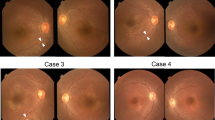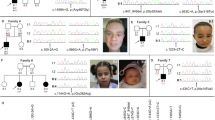Abstract
Leber congenital amaurosis (LCA, MIM 204000) accounts for at least 5% of all inherited retinal disease1 and is the most severe inherited retinopathy with the earliest age of onset2. Individuals affected with LCA are diagnosed at birth or in the first few months of life with severely impaired vision or blindness, nystagmus and an abnormal or flat electroretinogram (ERG). Mutations in GUCY2D (ref. 3), RPE65 (ref. 4) and CRX (ref. 5) are known to cause LCA, but one study identified disease-causing GUCY2D mutations in only 8 of 15 families whose LCA locus maps to 17p13.1 (ref. 3), suggesting another LCA locus might be located on 17p13.1. Confirming this prediction, the LCA in one Pakistani family mapped to 17p13.1, between D17S849 and D17S960—a region that excludes GUCY2D. The LCA in this family has been designated LCA4 (ref. 6). We describe here a new photoreceptor/pineal-expressed gene, AIPL1 (encoding aryl-hydrocarbon interacting protein-like 1), that maps within the LCA4 candidate region and whose protein contains three tetratricopeptide (TPR) motifs, consistent with nuclear transport or chaperone activity. A homozygous nonsense mutation at codon 278 is present in all affected members of the original LCA4 family. AIPL1 mutations may cause approximately 20% of recessive LCA, as disease-causing mutations were identified in 3 of 14 LCA families not tested previously for linkage.
This is a preview of subscription content, access via your institution
Access options
Subscribe to this journal
Receive 12 print issues and online access
$209.00 per year
only $17.42 per issue
Buy this article
- Purchase on Springer Link
- Instant access to full article PDF
Prices may be subject to local taxes which are calculated during checkout






Similar content being viewed by others
References
Kaplan, J., Bonneau, D., Frezal, J., Munnich, A. & Dufier, J.L. Clinical and genetic heterogeneity in retinitis pigmentosa . Hum. Genet. 85, 635–642 (1990).
Foxman, S.G., Heckenlively, J.R., Batemen, B.J. & Wirstschafter, J.D. Classification of congenital and early-onset retinitis pigmentosa. Arch. Ophthalmol. 103, 1502–1507 (1985).
Perrault, I., et al. Retinal-specific guanylate cyclase gene mutations in Leber's congenital amaurosis. Nature Genet. 14, 461–464 (1996).
Marlhens, F., et al. Mutations in RPE65 cause Leber's congenital amaurosis. Nature Genet. 17, 139–141 (1997).
Freund, C.L., et al. De novo mutations in the CRX homeobox gene associated with Leber congenital amaurosis. Nature Genet. 18, 311–312 (1998).
Hameed, A. et al. A novel locus for Leber congenital amaurosis with anterior keratoconus mapping to 17p13. Invest. Ophthalmol. Vis. Sci. (in press).
Sohocki, M.M., Malone, K.A., Sullivan, L.S. & Daiger, S.P. Localization of retina/pineal-expressed sequences (ESTs): identification of novel candidate genes for inherited retinal disorders. Genomics 58, 29–33 ( 1999).
Greenberg, J., Goliath, R., Beighton, P. & Ramesar, R. A new locus for autosomal dominant retinitis pigmentosa on the short arm of chromosome 17. Hum. Mol. Genet. 3, 915– 918 (1994).
Ma, Q. & Whitlock, J.P. Jr A novel cytoplasmic protein that interacts with the Ah receptor, contains tetratricopeptide repeat motifs, and augments the transcriptional response to 2,3,7,8-tetrachlorodibenzo- p-dioxin. J. Biol. Chem. 272, 8878– 8884 (1997).
Miyata, Y., et al. Phosphorylation of the immunosuppressant FK506-binding protein FKBP52 by casein kinase II: regulation of HSP90-binding activity of FKBP52 . Proc. Natl Acad. Sci. USA 94, 14500– 14505 (1997).
Endocrine role of the pineal gland. in Endocrinology (ed. Hadley, M.E.) 458–476 (New York, New York, 1996).
Furukawa, T., Morrow, E.M. & Cepko, C.L., Crx, a novel otx-like homeobox gene, shows photoreceptor-specific expression and regulates photoreceptor differentiation . Cell 91, 531–541 (1997).
Acknowledgements
We thank the LCA families for participation; O.L. June, C. Inglehearn, J. McHale and D. Hughbanks-Wheaton for expert assistance; and R. McInnes and D. Ing for providing the retinal northern blot. Supported by grants from the Foundation Fighting Blindness and the George Gund Foundation, the William Stamps Farish Fund, the M.D. Anderson Foundation, the John S. Dunn Research Foundation and by grant EY07142 from the National Eye Institute-National Institutes of Health (M.M.S., S.J.B., L.S.S. and S.P.D.) S.S.B. acknowledges support of the Medical Research Council (grant ref: G9301094) and the Wellcome Trust (grant ref: 049571/Z/96sol;Z) for research funding.
Author information
Authors and Affiliations
Corresponding author
Rights and permissions
About this article
Cite this article
Sohocki, M., Bowne, S., Sullivan, L. et al. Mutations in a new photoreceptor-pineal gene on 17p cause Leber congenital amaurosis. Nat Genet 24, 79–83 (2000). https://doi.org/10.1038/71732
Received:
Accepted:
Issue Date:
DOI: https://doi.org/10.1038/71732
This article is cited by
-
Inherited retinal disorders: a genotype–phenotype correlation in an Indian cohort and the importance of genetic testing and genetic counselling
Graefe's Archive for Clinical and Experimental Ophthalmology (2023)
-
Clinical and functional analyses of AIPL1 variants reveal mechanisms of pathogenicity linked to different forms of retinal degeneration
Scientific Reports (2020)
-
Retinal Organoids derived from hiPSCs of an AIPL1-LCA Patient Maintain Cytoarchitecture despite Reduced levels of Mutant AIPL1
Scientific Reports (2020)
-
NMR resonance assignments of the TPR domain of human aryl hydrocarbon receptor-interacting protein-like 1 (AIPL1)
Biomolecular NMR Assignments (2019)
-
Identification of a mutation in CNNM4 by whole exome sequencing in an Amish family and functional link between CNNM4 and IQCB1
Molecular Genetics and Genomics (2018)



